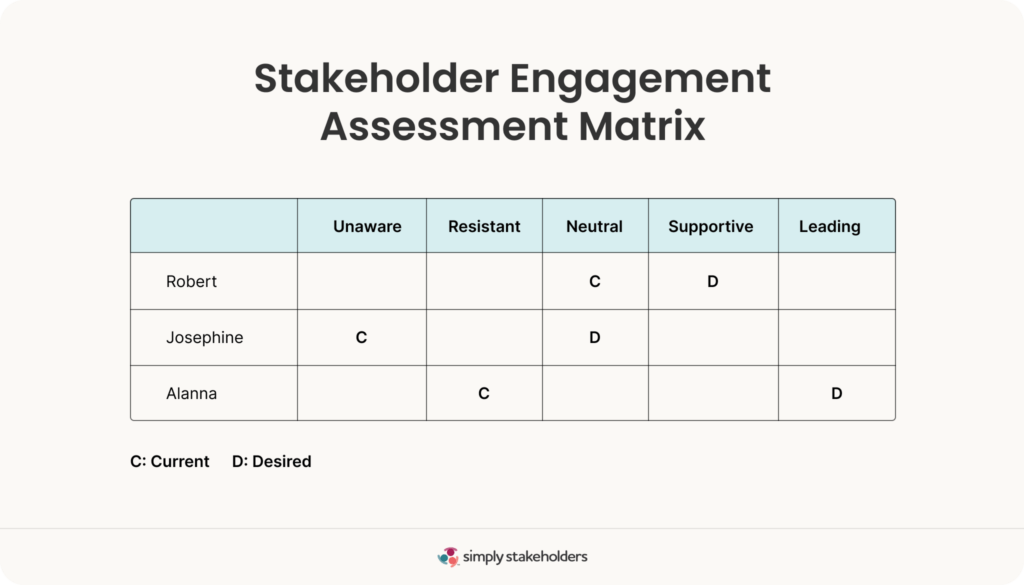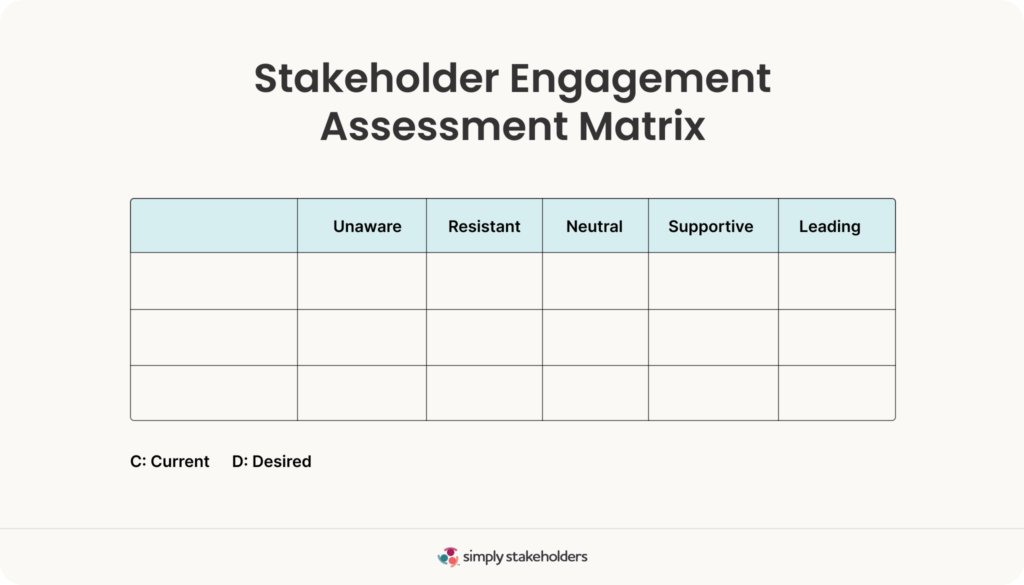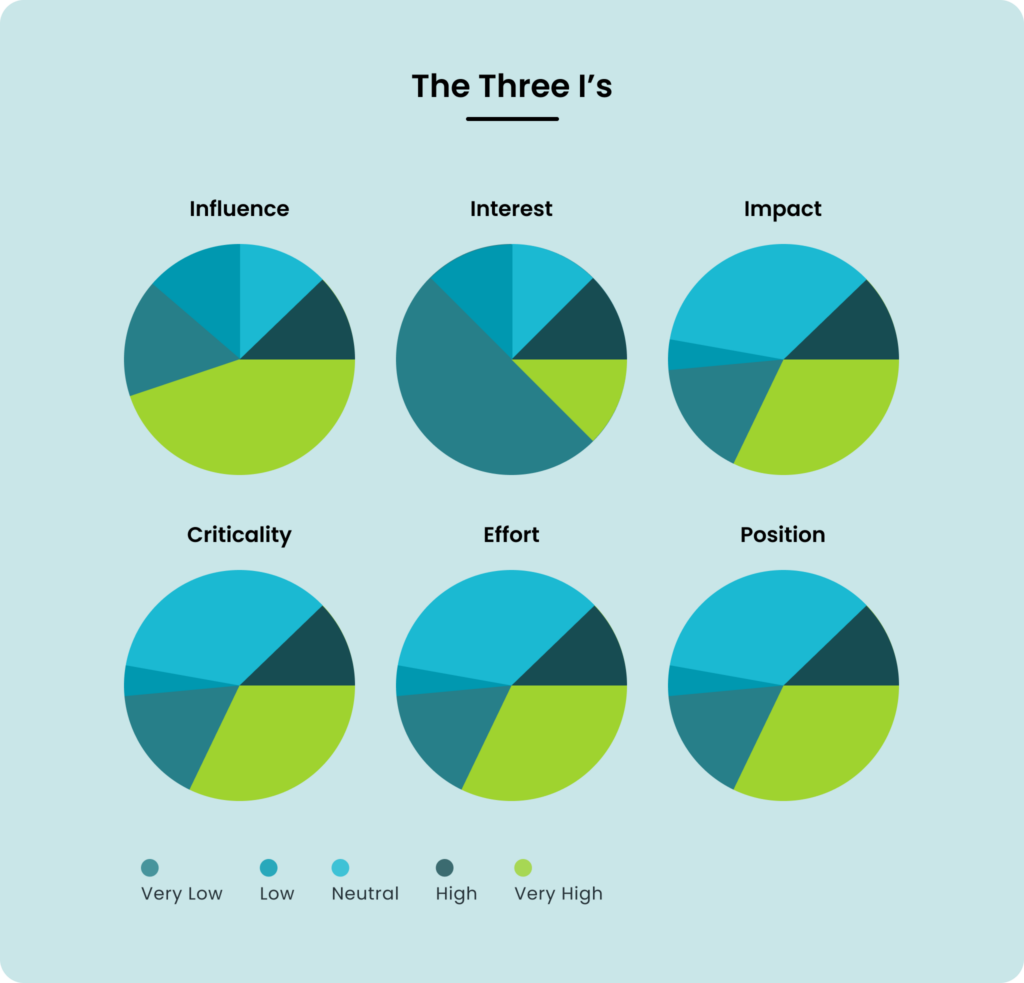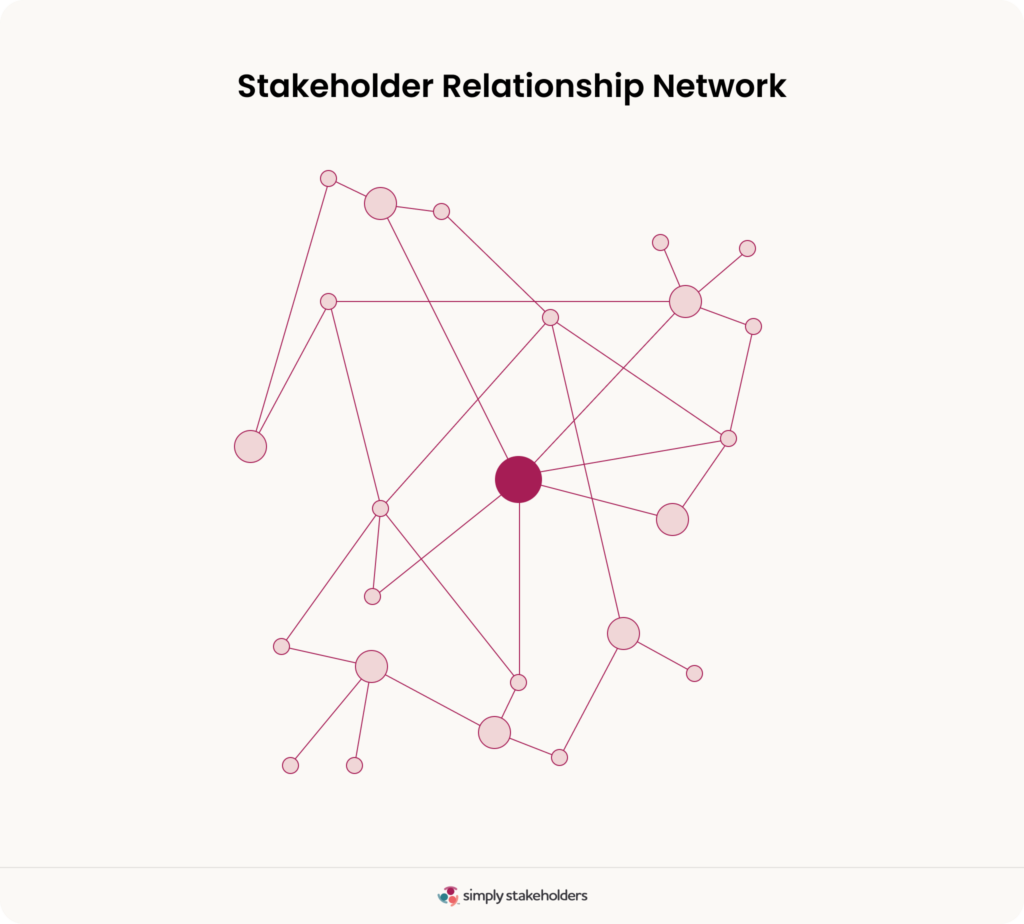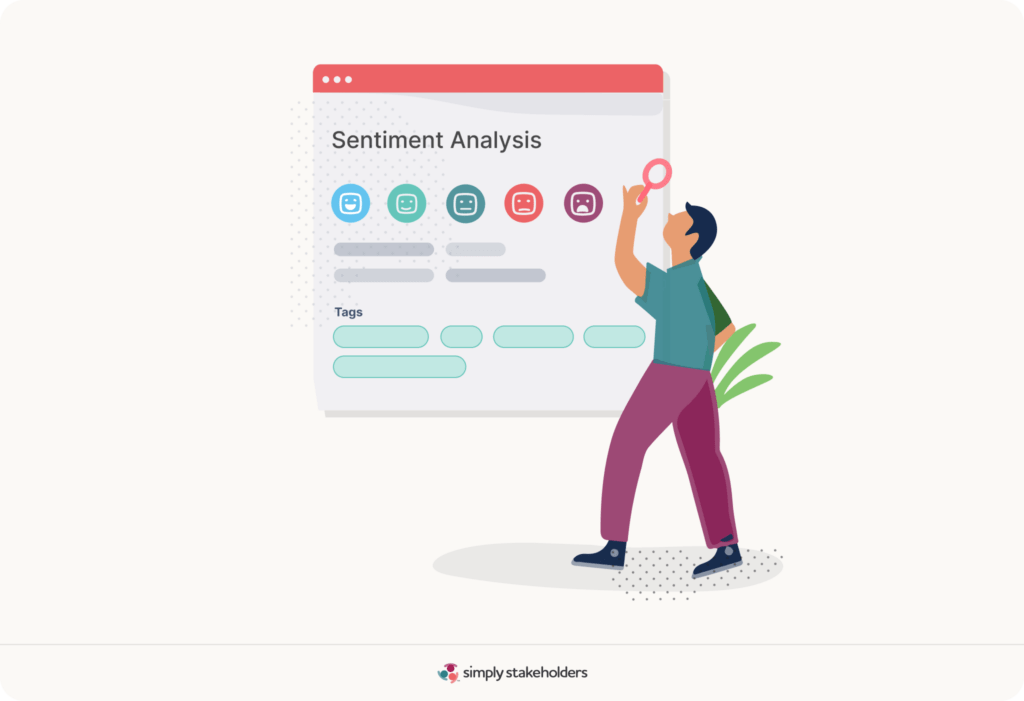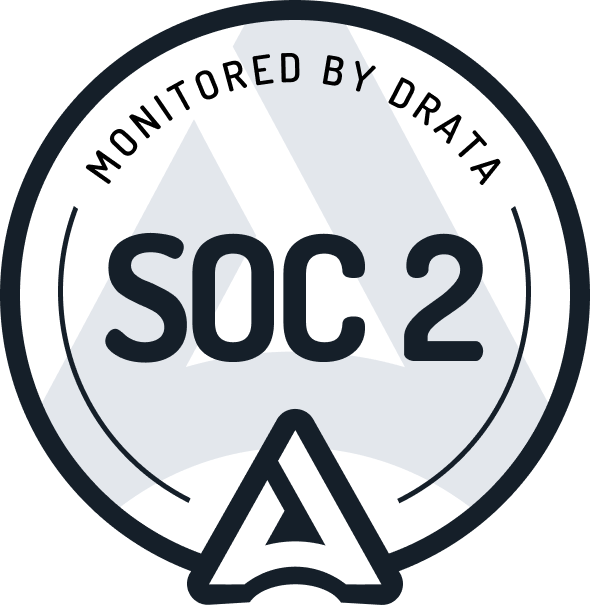Advanced stakeholder management
Stakeholder Engagement Assessment Matrix: Problems and Alternatives
Need to monitor the progress of your stakeholder engagement for reporting, evaluation, or to adjust your...

Need to monitor the progress of your stakeholder engagement for reporting, evaluation, or to adjust your strategies and plans? One tool you may have come across is the stakeholder engagement assessment matrix.
In this guide, we define this matrix framework and explain how you could use it to evaluate your stakeholders and engagement campaigns. But we also dive deeper into some of the problems associated with this matrix, and some better alternatives for assessing a stakeholder engagement.
What Is the Stakeholder Engagement Assessment Matrix?
The stakeholder engagement assessment matrix is a framework used to evaluate a stakeholder engagement based on stakeholders’ current level of engagement in the project. This is then compared with the desired level of engagement in order for the project to be successful.
Organizations or project managers may use the framework to:
- Identify which stakeholders may need to be prioritized based on the gap between their current and desired state
- Develop a stakeholder engagement plan or strategy
- Determine what kind of communication and activities may be suited for stakeholders based on their current or desired level of engagement
- Monitor changes in stakeholder engagement throughout the project by comparing an initial stakeholder engagement assessment matrix with another version completed mid-project
- Report on progress and KPIs
Example stakeholder engagement assessment matrix models can be seen in this research paper discussing analysis and management processes of project stakeholders and this study on the effects of stakeholders engagement and communication management on project success.
Breaking Down the Stakeholder Engagement Assessment Matrix
In other stakeholder matrix models we’ve previously explored, two levels of two different stakeholder dimensions or characteristics are displayed on each axis, creating four potential quadrants for plotting stakeholders.
However, the stakeholder engagement assessment matrix is formatted like a table or spreadsheet, with as many stakeholders as you need listed in the first column, and five varying levels of engagement displayed along the top row. This simple layout means that some organizations simply incorporate the matrix into their existing stakeholder spreadsheets.
Let’s break these components down further and what they mean:
Y-Axis: Stakeholders
The Y-Axis is simple — this is where your stakeholders are listed. You may list the names of individuals who are impacted by, have an influence on, or an interest in your organization, work, or project. Or you may list groups or organizations that are your stakeholders.
X-Axis: Engagement Levels
The X-Axis should display the five engagement levels. Here are the levels and what they mean:
- Unaware – Does not yet know about the project or what it may impact
- Resistant – Does know about the project and what it might impact, but does not support its goals or work
- Neutral – Does know about the project, but does not support or oppose it
- Supportive – Does know about the project and supports its goals and work
- Leading – Does know about the project and is actively involved and working towards the project’s success
Current Vs Desired
The final part of the stakeholder engagement assessment matrix is the C and D marked in each row. The C should go underneath your stakeholder’s current level of engagement, and the D should go underneath the level of engagement you desire for them in order for your project to be successful. Note that if your stakeholders are already at their desired level of engagement, you’ll place both C & D in the same column.
Problems With the Stakeholder Engagement Assessment Matrix
Now that you know what the stakeholder engagement assessment looks like and how it works… should you use it in your stakeholder planning, classification, and engagement processes?
The short answer is: no.
The long answer is that it’s not an ideal stakeholder framework for several reasons:
It’s outdated. While this model may have been appropriate at one time, times have changed and it no longer delivers meaningful insights, with more stakeholders now having the power to influence a project and the right to engage. Therefore, organizations need to aim for broader engagement levels and more inclusive engagement. Not only that, but it’s perhaps not ideal to use language like “unaware” or “resistant” to describe people.
It’s oversimplified. Assessing your stakeholder engagement based on an assumed “level of engagement” is very one-dimensional and captures very little information of practical value. It says nothing about relationships, impact, interests, influence, how critical they are to your project, or how much effort it might take to engage them. It’s unlikely that you could segment your stakeholders or tailor your communication in a meaningful way based on their current or desired level of engagement.
It’s hard to read. Unlike other stakeholder mapping techniques and even other stakeholder matrix models, it’s hard to visualize the overall position of your stakeholders and the progress of your engagement from the stakeholder engagement assessment matrix. You need to look at each line to interpret each individual stakeholders’ position (C and D look somewhat alike from a distance!), and it is difficult to zoom out and understand the big picture.
Fortunately, there are a number of better alternatives you can use for assessing your stakeholders.
3 Better Alternatives for Assessing Your Stakeholder Engagement
There are many other methods of stakeholder analysis or stakeholder mapping that you could use to assess your stakeholder engagement. However, we wanted to highlight the following three approaches due to their comprehensiveness and practicality — they will deliver useful insights and are well worth revisiting before, during, and after your stakeholder engagement is complete.
Interest/Influence/Impact Mapping
Otherwise known as the Three I’s Method of Stakeholder Mapping, this approach involves assigning a level or scale to various dimensions in order to identify which stakeholders you may need to prioritize with engagement earlier on, or more regularly:
- Interest (Low, Medium, High) – How interested are they in the project?
- Influence (Low, Medium, High) – How much influence could they have on the project?
- Impact (Low, Medium, High) – How much will the project impact them?
- Criticality (Low, Medium, High) – How much do they matter for project outcomes?
- Effort (Low, Medium, High) – How much effort will you need to engage them?
- Position (Very Negative, Negative, Neutral, Positive, Very Positive) – How do they feel about the project?
This method is built into the Simply Stakeholders software, and we’ve recently added the final three dimensions to increase its accuracy and practical application. Inside Simply Stakeholders, you can assign the attributes to stakeholders so you can easily analyze stakeholders, categorize them, prioritize them, and generate reports. Most importantly, you can update your assessment for any stakeholder at any point in the engagement, and your changes will be reflected in the reports.
| In Action: Using this Method for Stakeholder Engagement Assessment
One example scenario where this method of stakeholder engagement assessment could be used is for a new dam construction. While they were still planning the project and engagement, the project management team used the 6 criteria to assess each stakeholders’ level of interest, influence, impact, criticality, effort, and position. This revealed which stakeholders they would likely need to engage with early on — and those that would need closer management (residents within the vicinity, businesses using the existing waterways, regulators, experts, and developers). Immediately, they were able to create stakeholder segments and develop a stakeholder plan. They kept their stakeholder software up to date with new stakeholders and any changes to the status of existing stakeholders so that they were able to track how their activities were impacting stakeholders’ position, and to ensure their priorities were still correct. Any changes were also used for reporting and evaluation. |
Stakeholder Relationship Network
Another key aspect to engaging with stakeholders is relationships — so it’s a good idea to record your relationships so that you can evaluate whether you’re on track or not. There are several methods you could use to map and track stakeholder relationships, but perhaps our favorite is the stakeholder relationship network diagram.
This method involves visualizing your stakeholders in a mindmap-style diagram, using lines to show relationships between stakeholders. Depending on whether you manually draw this using pen/paper or use software, you may be able to show different information about your stakeholders and their relationships through colors, shapes, sizes, and more.
Ideally, you’d use stakeholder software that is specifically designed for visualizing stakeholder data and relationships — especially if it allows for collaboration, easy updating, and integrations with other tools. We’re building relationship mapping tools like this inside Simply Stakeholders, along with our relationship health score that helps to highlight the strength of your relationships and any areas that you may need to focus on.
| In Action: Using this Method for Stakeholder Engagement Assessment
To understand how the stakeholder relationship network diagram could be used to assess your stakeholder engagement, consider a corporate merger between two large consulting firms. In order for the merger to be successful, the team leading the process needed to engage with stakeholders, and place substantial focus on identifying the various complex relationships already in existence — and building new ones. They created a network diagram to visualize these relationships from the start, and were able to identify that several stakeholders from each company already had relationships with the other company. These individuals were engaged first on the assumption that they would be more likely to support the merger. The project team then focused on strategically building new relationships between both companies via events, meetings, and communications — in conjunction with announcing the merger. Each new relationship was tracked and updated in the network diagram, and this helped them plan team-building activities between the two organizations. |
Sentiment Analysis
Finally, tracking stakeholder sentiment is another excellent method of assessing your stakeholder engagement. If possible, you could determine stakeholder sentiment at the start of the project (before engagement), during the project, and after the project. This may help you to understand the level of stakeholder support, and whether any particular engagement activities or project milestones triggered a change in sentiment.
There are several methods you could use to track and analyze stakeholder sentiment:
- Surveys – You could ask stakeholders how they feel about various aspects of the project (directly or indirectly)
- Manual qualitative analysis – You could analyze stakeholder comments or transcripts from conversations with stakeholders and assign a positive, negative, or neutral sentiment to each
- Automatic qualitative analysis – You could use a tool that will analyze stakeholder comments, emails, and transcripts for you to determine a positive, negative, or neutral rating
Qualitative analysis can be an extremely useful method — especially if you have a lot of data to work with. But manually analyzing large volumes of data is not practical for the most part. That’s why inside the Simply Stakeholders stakeholder management system, we’ve included AI-driven sentiment analysis that automatically determines sentiment across any comments, emails, and other data attached to your stakeholder records.
| In Action: Using this Method for Stakeholder Engagement Assessment
To understand how sentiment analysis could be used to assess your stakeholder engagement, consider a council project involving beautifying a beachside strip with fairy lights to help attract more visitors at night. After identifying potential stakeholders, the council began tracking their stakeholder communication in software. This software quickly identified the sentiment associated with communication throughout the consultation and engagement period, showing which stakeholders would require further information and engagement in order to increase their support. After the council hosted a casual evening event at the beachside strip, they saw a significant increase in positive sentiment across all stakeholder groups, and decided to schedule additional events over the coming months. As a result, they met with very little resistance to the project and were able to install the fairy lights, leading to a 30% increase in visitors after dark. |
When to Assess Your Stakeholder Engagement
Too many organizations only assess their stakeholders at the start of the project. They (or their consultants) do stakeholder analysis and mapping, and then it just sits there in a folder or document that isn’t used to inform decisions, evaluate progress, or report on issues in the context of their stakeholder mapping groups.
But we believe that stakeholder engagements should be assessed regularly — quarterly, or at project milestones, and certainly at the end of the project. That way, you’ll have more valuable data to assess your progress, identify risks, monitor issues, set your priorities, and make better-informed decisions.
It’s easy to understand why so many organizations fall short. If you’re not using a practical method to assess your stakeholders, why would you bother picking it up again? And if your stakeholder assessment is too much work or manual labor, you probably don’t have time to repeat your assessment.
That’s why we strongly recommend moving away from tools like the stakeholder engagement assessment matrix, and instead using more modern methods that give you actionable insights. And ideally, are integrated into your stakeholder software to make updating your assessment simple, easy, and even automated.
Assessing Stakeholders for Engagement in Simply Stakeholders
All three alternative methods to assess stakeholder engagements are available inside Simply Stakeholders — stakeholder mapping, stakeholder relationship mapping, and sentiment analysis. And they’re perfect for using throughout the entire stakeholder engagement process, from pre-consultation planning through to post-project evaluation and reporting.
Learn more about how it works or reach out if you’d like to book a demo with our team. We’d love to show you our tools in action!

